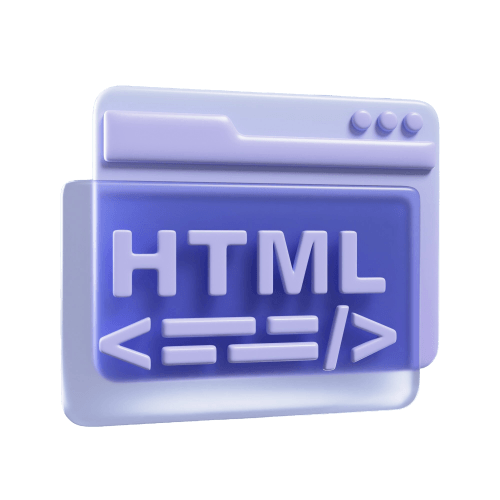In the world of web content creation and documentation, two popular tools often come into play: (HyperText Markup Language) HTML and Markdown. While both serve the purpose of formatting text for online consumption, they cater to different audiences and needs. HTML is the backbone of web pages, offering unparalleled control and flexibility, whereas Markdown shines in its simplicity and ease of use. Lets explore the key differences between these two tools, their pros and cons, and their ideal use cases to help you decide which one suits your requirements.
On This Page
Table of Contents
What is HTML?
HTML, or Hypertext Markup Language, is the standard language used to create web pages. It serves as the foundation for nearly all websites, allowing developers to structure content and embed various online features. By using HTML elements, one can define paragraphs, lists, links, images, and more, making it an essential skill in web development.

Key Features of HTML
- Structured Content: HTML documents are organized into elements that define headings, paragraphs, lists, and other types of content.
- Cross-Browser Compatibility: HTML is universally interpreted by all web browsers, ensuring consistent display across different platforms.
- Embedding Media: HTML allows users to integrate images, videos, and audio into web pages, enhancing user experience.
Common Use Cases for HTML
HTML is extensively used for:
- Building Static Web Pages
- Creating Email Templates
- Developing Web Applications
For example, to create a simple layout in HTML, consider the following code snippet:
<h1>Welcome to My Website</h1>
<p>This is a basic introduction to HTML.</p>
<a href="https://www.cloudcusp.com">Visit cloudcusp</a>Additionally, HTML also provides a way to create tables for organized data presentation:
<table> <tr> <th>Name</th> <th>Age</th> </tr> <tr> <td>John</td> <td>30</td> </tr></table>What is Markdown?
Markdown is a lightweight markup language that allows users to format text easily using plain text syntax. Its goal is to make writing and formatting documents simple and accessible. 📝 With Markdown, you can create content for websites, readme files, or even documents with minimal effort.

Markdown was created by John Gruber in 2004. Its primary aim was to facilitate the conversion of plain text into HTML, enhancing readability and ease of use. Over time, its simplicity and versatility contributed to its popularity across numerous platforms.
Why Use Markdown?
- Ease of Use: Markdown is intuitive; writers can easily convert text to HTML without complicated commands.
- Cross-Platform Compatibility: Markdown files can be opened and edited in any text editor on any device.
- Focus on Content: It allows creators to concentrate on writing, rather than formatting.
Common Applications of Markdown
Markdown is commonly used in many platforms. Here are some examples:
| Platform | Usage |
|---|---|
| GitHub | For README files, documentation, and project notes. |
| For formatting posts and comments. | |
| Notion | For creating rich-text documents. |
Examples of Markdown Syntax
Here are two simple coding examples to illustrate Markdown functionality:
# Header 1 ## Header 2 - Point 1 - Point 2 **Bold Text** *Italic Text* To sum up, Markdown offers simplicity and effectiveness for both beginners and seasoned professionals. Embracing its use can enhance your writing experience and improve document readability! 🌟
Key Differences Between HTML and Markdown
When it comes to web content creation, both HTML (Hypertext Markup Language) and Markdown serve essential roles. Each has its own unique characteristics, purposes, and audiences, making them suitable for different scenarios.
Syntax Comparison
The most noticeable difference lies in their syntax. HTML uses angle brackets to define elements, making it more complex. For example, a simple heading in HTML would look like this:
<h1>This is a Heading</h1>In contrast, Markdown is designed to be easier for users. You can create a heading with a simple # :
# This is a HeadingThis simplicity makes Markdown easier to learn for beginners and faster to write.
Flexibility vs. Simplicity
HTML offers more flexibility, allowing developers to create intricate web applications with various features. However, this comes with a learning curve. On the other hand, Markdown prioritizes simplicity over complexity. Its ease of use makes it perfect for quick documentation and note-taking. Here’s a comparison:
- HTML: High flexibility, complex syntax, steep learning curve.
- Markdown: Simplicity, easier usage, limited features.
Use Cases
Choosing between HTML and Markdown often depends on the project requirements. If you need more control over web presentations like forms, charts, or interactive content, HTML is the way to go. Alternatively, for quick and clean formatting, especially in README files or basic blogs, Markdown is preferable.
Advantages and Disadvantages of HTML
Advantages of HTML
HTML comes with several notable benefits:
- Customization: HTML allows developers to create bespoke layouts and designs tailored to specific needs.
- Multimedia Support: The language enables the easy incorporation of images, videos, and audio, enriching the user experience.
- Compatibility: HTML is universally supported across all web browsers, ensuring consistent display of content.
For example, a simple HTML snippet for embedding a video might look like this:
<video controls> <source src="video.mp4" type="video/mp4">
Your browser does not support the video tag.</video>
Explanation:
<video controls>:- This is the
<video>element used to embed a video on a web page. - The
controlsattribute enables playback controls like play, pause, volume, etc.
- This is the
<source>:- This element specifies the video file and its type.
- The
src="video.mp4"specifies the path to the video file. - The
type="video/mp4"indicates the format of the video.
- Fallback Text:
- The text
Your browser does not support the video tag.is displayed if the browser does not support the<video>element.
- The text
Disadvantages of HTML
However, HTML is not without its challenges:
- Complexity: For larger websites, managing extensive HTML documents can become cumbersome and error-prone.
- Verbosity: HTML can lead to long and convoluted code, especially when additional libraries are included.
Consider a bloated HTML code below:
<html> <head> <title>Sample Page</title> </head> <body> <p>Content</p> </body></html>
HTML has numerous advantages including customization, multimedia support, and compatibility. Conversely, its complexity and verbosity can pose challenges.
Advantages and Disadvantages of Markdown
Markdown is a lightweight markup language designed for formatting text. Its simplicity and ease of use have made it popular among writers, developers, and content creators. However, like any tool, it has its strengths and weaknesses.
Advantages of Using Markdown
- Simplicity: Markdown uses a plain text syntax, making it easy to learn and write. With just a few symbols, users can create formatted text.
- Readability: Unlike complex formatting languages, Markdown allows for clear and easy-to-read documents. The plain text can be read without rendering.
- Portability: Markdown files are portable across different platforms and applications. They can be easily converted to HTML, PDF, and other formats.
Disadvantages of Using Markdown
- Limited Functionality: While Markdown covers basic formatting needs, it lacks advanced features found in full-fledged word processors.
- Reliance on Extensions: To achieve specific functionalities like footnotes or advanced table formatting, users often depend on third-party extensions, which may not be universally compatible.
- For instance, creating a complex table in Markdown can be tricky, often requiring additional tools.
Markdown offers significant advantages such as simplicity, readability, and portability, making it an excellent choice for many users. However, its disadvantages, including limited functionality and reliance on extensions, can restrict its use for specific applications. Ultimately, the decision to use Markdown depends on your individual needs and preferences.
Use Cases: When to Choose HTML
HTML, or HyperText Markup Language, is the backbone of any web page. Whether you are a professional web designer or just a beginner, knowing when to choose HTML is crucial. HTML is especially beneficial for creating structured layouts and ensuring your content is easily accessible to users and search engines alike.
When to Use HTML
There are several scenarios where HTML shines:
- Simple Web Pages: For basic content pages, using HTML allows for a straightforward approach to organize and publish your material.
- Data Representation: HTML is ideal for displaying data in tables, making complex information easy to read. For example, using a table to show product specifications helps users compare features effectively.
- Interactive Content: Combining HTML with CSS and JavaScript enables the creation of interactive elements, like forms and buttons, enhancing user experience.
Creating Tables with HTML
HTML tables are a powerful way to present data. Here’s a simple example:
| Product | Price |
|---|---|
| Example Product A | $20 |
| Example Product B | $30 |
Tables like this not only facilitate the organization of information but also improve comprehension for the reader.
Choosing HTML is essential for developing complex layouts and interactive designs. With its ability to create structured documents, HTML remains a fundamental skill for anyone involved in web design and development.
Use Cases: When to Choose Markdown
Markdown is a lightweight markup language that facilitates the creation of formatted text using a plain-text editor. Its simplicity allows users to write with ease while ensuring enhanced readability and straightforward conversion to HTML.
Markdown for Technical Documentation
When crafting technical documentation, Markdown shines due to its ability to structure information effectively. For instance, you can effortlessly create tables to present data clearly:
| Feature | Description ||—————|————————|| Markdown | Lightweight markup || HTML | Hypertext markup language|
Additionally, using bulleted points in Markdown is particularly useful for listing features or instructions, as it provides a clean layout that is easy to skim:
- Easy to learn
- Compatible with various platforms
- Supports links and images
Markdown for Blogs
Markdown is an excellent choice for creating blog posts due to its simplicity and versatility. Authors can focus on content creation without getting bogged down by the complexities of HTML. For example, leveraging Markdown allows you to format headings with ease:
# H1 Heading ## H2 Heading ### H3 Heading
Furthermore, the incorporation of keywords can enhance SEO while maintaining clarity. For instance, phrases like ‘lightweight content creation’ and ‘technical documentation’ can be easily highlighted to draw the reader’s attention.
Tools and Editors for HTML and Markdown
In the world of web development and content writing, tools for HTML and Markdown play a crucial role. These editors not only enhance productivity but also simplify the process of content creation and coding. Let’s explore some of the most popular choices available today.
Top HTML Editors
When it comes to HTML editing, several tools stand out for their features and user-friendly interfaces. Here are a few notable options:
- Visual Studio Code: Known for its extensive range of extensions and features, this open-source editor supports live server preview.
- Sublime Text: A minimalist editor that ensures speed without sacrificing functionality, offering syntax highlighting and autocomplete.
Essential Markdown Tools
Markdown tools enable writers to format their text quickly and efficiently. Here are some of the most recommended:
- Obsidian: A knowledge base tool that allows for seamless linking and organization of notes with Markdown support.
- Typora: A WYSIWYG editor that provides a distraction-free experience and instant preview of Markdown formatting.
Choosing the right tool can significantly impact your coding and writing experience. Consider HTML editors like Visual Studio Code and Sublime Text, alongside Markdown solutions such as Obsidian and Typora, to enhance your productivity. Each of these tools offers specific features that cater to different needs, making it easier to create high-quality content.
How to Combine HTML and Markdown
HTML (HyperText Markup Language) and Markdown are both markup languages that serve different purposes. HTML is widely used to create web pages, while Markdown is a simpler way to format text. Combining them can lead to more dynamic and robust documentation, especially for complex projects.
Embedding HTML in Markdown
When using Markdown, you might find the need to incorporate HTML elements for advanced formatting. To do this, simply place the HTML code within your Markdown text. For example:
This is a bold statement.
You can make more complex structures like a table:
| Header 1 | Header 2 | |----------|----------| | Row 1 | Cell 1 | | Row 2 | Cell 2 |This table integrates HTML table elements seamlessly into Markdown text.
Creating Lists and Emphasizing Text
Markdown makes it easy to create bulleted points, which can enhance the visual structure of your content. Here’s how to format a simple list:
- Point one: Description of point one.
- Point two: Description of point two.
- Point three: Description of point three.
By utilizing both HTML and Markdown, you can emphasize keywords and create a visually appealing content layout.
In Closing
HTML and Markdown are not competitors but complementary tools, each with its own strengths. HTML is a robust and detailed language designed for creating fully-fledged web pages, while Markdown offers a lightweight and user-friendly approach to formatting text. Whether you prioritize simplicity or control depends on your goals.
FAQS
What is the main difference between HTML and Markdown?
HTML is a full-fledged markup language used to create complex web pages, while Markdown is a lightweight markup language designed to simplify text formatting.
Which is easier to learn: HTML or Markdown?
Markdown is easier to learn because its syntax is simple and intuitive, while HTML has more complex tags and structure.
Can I use HTML and Markdown together?
Yes, most Markdown editors allow you to include HTML for advanced formatting or features that Markdown doesn’t support.
When should I use Markdown instead of HTML?
Use Markdown when writing blogs, documentation, or notes, where simplicity and readability are important.
Is Markdown supported everywhere?
Markdown is supported by many platforms like GitHub, Reddit, and WordPress, but it’s not as universal as HTML for creating web pages.
Does Markdown allow styling like HTML?
Markdown supports basic styling like bold, italics, and lists, but it doesn’t offer the advanced design and layout capabilities of HTML.
Is Markdown only for developers?
No, Markdown is for anyone who wants a simple way to format text, including writers, bloggers, and content creators.
What are the limitations of Markdown?
Markdown is limited in terms of design and functionality. For anything beyond basic formatting, you’ll need to rely on HTML or extensions.
Why is Markdown so popular?
Markdown is popular because it’s easy to use, readable even without rendering, and supported by many modern tools and platforms.
Do I need any special tools to write in HTML or Markdown?
You can write HTML or Markdown in any text editor, but tools like Visual Studio Code (for HTML) or Typora (for Markdown) can make it easier.








